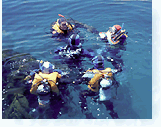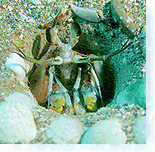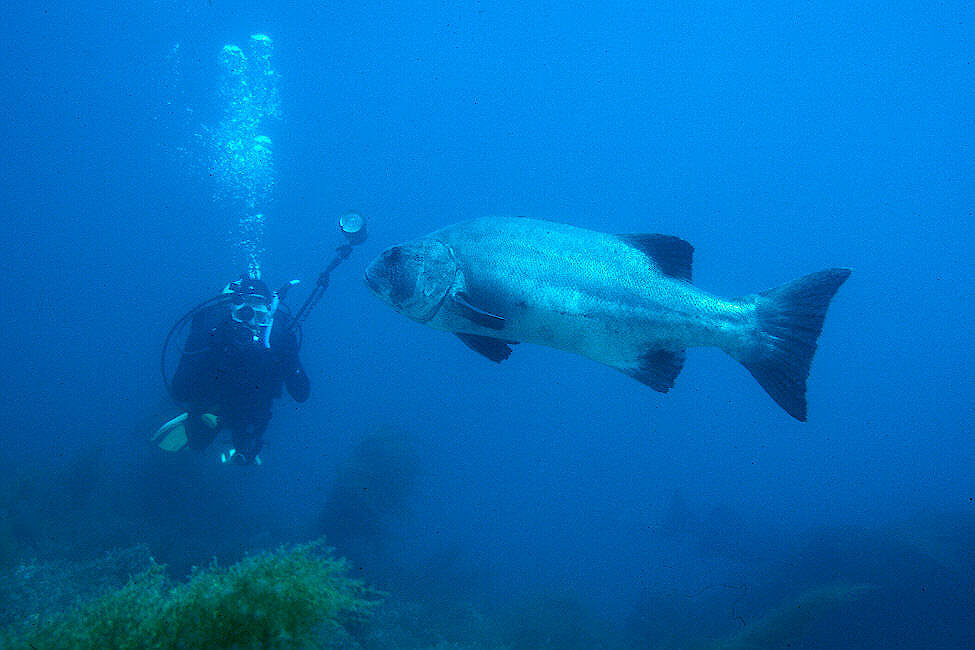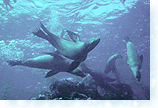 California diving is tremendously diverse.
Conditions and underwater terrain
will vary from island-to-island (let alone day-to-day). Below are descriptions of the areas we visit, and a general idea of what you might
expect to find when you join us on a trip to these areas. California diving is tremendously diverse.
Conditions and underwater terrain
will vary from island-to-island (let alone day-to-day). Below are descriptions of the areas we visit, and a general idea of what you might
expect to find when you join us on a trip to these areas.
CATALINA ISLAND
Located roughly 20 miles from the mainland, Catalina is the most-visited
of the
four Southern Channel Islands. It is generally considered "easy" diving, though
there are many advanced sites as well. Since the island is over 20 miles long and
impossible to cover in one day, we break it up as follows:
West End - the northwestern part of the island, from Arrow Point to the West End.
Includes such sites as Last Cove (where bald eagles nest), Johnson's Rock
 (good for octopus), Black Rock, Starlight, and Arrow Cove (where you might spot a
mantis shrimp). (good for octopus), Black Rock, Starlight, and Arrow Cove (where you might spot a
mantis shrimp).
Front side - the northeast corner of the island and then halfway down the lee side,
from Arrow Point to Red Bluffs. Includes Doctor's Wall & Doctor's Cove, Emerald Bay
& Indian Rock (good chance at bat rays), Big & Little Geiger, Eagle Reef, Lion's
Head, Isthmus Reef, Ship Rock (a fabulous dive with gorgeous yellow anemones covering
the area), Bird Rock, Blue Caverns, the Quarry, and Yellowtail Point some
of the spots we visit.
Italian Gardens - This is where we've regularly been spotting
Giant Black Sea Bass (see picture below left), sometimes as many as a
dozen. We generally try to make two dives in this spot so that you
get great opportunities to view (and perhaps photograph) these
gentle giants.

East End - middle of the front side through Avalon around to the southwest corner, Red
Bluffs to Church Rock. Most of these trips start at either the wreck of the
Valiant
(127' feet long and sitting in 60-100' of water - the largest pleasure yacht of her
time when she burned and sank in 1927), at Little Farnsworth (small underwater
pinnacle with a top of 50' and a bottom that exceeds recreational
depths), or at Italian Gardens.
Other
sites in this area include Church Rock, the Southern Quarry, K20, Hen Rock, and Long
Point.
FARNSWORTH BANKS/CATALINA BACKSIDE
To start with, this is a VERY ADVANCED DIVE
and not one to be taken lightly. Mistakes made at
Farnsworth can quickly become life-threatening due to the depths involved, exposure to
ocean currents, and distance from the island. The shallowest part of Farnsworth is
roughly 60' deep and it's very easy to find depths in excess of
recreational limits. Generally this dive is done around 100' or so.
We're happy to provide escorts when we can, but this is not the
place to be if you don't have your diving act together. It very beautiful,
but definitely a dive for experienced divers and not a good choice
for newbies (unless you want to skip Farnsworth and wait for the
in-shore 2nd and 3rd dives.)
That being said . . . Farnsworth Bank is a spectacular pinnacle
that lies a few miles off Catalina's backside. It's covered with purple hydrocoral
(which is protected by state law) and frequented by many pelagic species of fish. It's
not uncommon to see schools of herring or small jacks being herded by yellowtail or
barracuda. We've also encountered Ocean Sunfish (mola mola) when visiting Farnsworth.
After Farnsworth, other sites we might
visit include Pedestal Rock, Lobster Bay, Ironbound Cove, Cape
Cortes, Gull Rock (aka Farmer's Rock), and Finger Rock.
SANTA BARBARA ISLAND
SBI is the smallest of the Southern Channel Islands, so we don't split it up as it's
possible to dive all sides of the island in a single day. But it's size works against
us as Santa Barbara also reacts more quickly to adverse ocean conditions.
But the island definitely has one of SoCal's top attractions - an
enormous sea lion rookery, filled with stand-offish adults, territorial bulls, and
incredibly curious juveniles. We can almost guarantee (note that the operative word
is "almost") you'll see at least one sea lion, if not dozens, on a trip to Santa Barbara. In fact, depending on the time of the year, it's possible to do four dives and never be
without a pinniped escort.
Popular spots at SBI include Black Caverns (tricky to find but big enough to drive a boat
through - if the boat was submerged at 100'), SE Kelp (actually a variety of spots
ranging in depth from a mini-wall at 100' to a shallow extension of an underwater ridge with
small swim-troughs), Sutil Island (also numerous spots), Three Sisters (good for horn
sharks, bat rays, and sometimes leopard sharks in the shallows), the Arch (a stunning
natural underwater arch with a variety of sea life surrounding it), Webster's Point,
Elephant Seal Cove (if the big fellas are on the beach, keep your distance), Shag Rock,
Dry Arch Wall, Landing Cove, Ken's Cave (a truly delightful shallow - 15' deep - tunnel
with two blowholes in  the back, resident sea lions zooming in and out, and an
exit all the way back and to the
right that puts you behind a natural seawall where you can watch waves break overhead
and exit through a small archway), and the Rookery (a large area where the majority of the
sea lions haul out, breed, and do whatever it is that sea lions do to pass time). the back, resident sea lions zooming in and out, and an
exit all the way back and to the
right that puts you behind a natural seawall where you can watch waves break overhead
and exit through a small archway), and the Rookery (a large area where the majority of the
sea lions haul out, breed, and do whatever it is that sea lions do to pass time).
SAN CLEMENTE ISLAND
The largest of the Southern Channel Islands at over 27 miles long, we also divide San
Clemente into four sections as it's impossible to see it all in one trip. Clemente is
owned by the U.S. Navy and serves as home to a base in NW Harbor, which also includes
Navy Seal training facilities. So it's not uncommon to see naval activity around the island.
Occasionally, we'll get "buzzed" by pilots who are flying the Navy's latest fighter
aircraft. And, on rare occasions, we've spotted nuclear submarines cruising the waters.
The Navy ownership also means that sometimes some of the dive sites are put off-limits to
us for security reasons &/or naval training operations
(frequently "live" fire) being conducted in a specific
area. Also be aware that the Navy can "close" areas of the
island to diving, meaning we have to choose an alternate site or
even not go to Clemente at all.
NW - the northern end of the island, from the edge of West Cove around the top to LCI
Point, where the restricted area begins. Popular sites includes Castle Rock (also known as
Target Rock since the fighters use it for target practice), Purple Boilers (where you can
find purple hydrocoral in 40' of water), 9-Fathom Reef (a gorgeous deep-water reef that
lies a mile or so off the island), Perfume Point (covered in guano - hence the name - but
a diverse shallow-water dive), the wreck of the Butler, LCI or Coco Point (an incredible
array of sea life found in a rocky boulder area ranging from 60' to 5' in depth and nestled
in a luxuriant kelp forest), Runway Kelp (at the base of the Navy airstrip), Mickey Mouse,
and (true) LCI (another healthy kelp reef located about 100 yards offshore).
Frontside - middle of the lee side down to the SE corner, from the south end of the
permanent closure to East End Reef. This part of the island is know for it's sheer walls
that start shallow and will drop down into the abyss. Includes Purse Seine Reef (Ken Kurtis
may be the only one who likes this spot), Red Hawk (Black Sea Bass sighted here), Wagon
Tracks, Rainfall, Little Flower (nice large reef named for the fishing vessel that wrecked
here years ago), Windowpane (a marvelous double-pinnacle that comes within 30 feet of the
surface and drops down to over 150'), Fishhook (really three different dives - in the cove,
along the wall, or around the north end), Twin Caves, and Last Cove.
Pyramid - SE corner to the SW corner, from East End Reef through Pyramid Cove to China
Point. Contains some of our most popular dive sites and areas that range from walls to
arches to canyons to shelves. Includes East End Reef (series of channels and
a healthy kelp forest),
Pyramid Wall (which you could spend a whole day exploring either deep or shallow), Fishnet
(a pinnacle 100 yards seaward of Pyramid Wall), the Arch (another amazing underwater arch,
but this time 100' deep), the Boilers (Inside & Outside), Blockhouse Reef (full of horn
sharks), the Bluffs (an excellent night anchorage and also where we first started spotting
Guadalupe Cardinal fish during the El Nino in the mid-90s), CHP Reef, and China Point.
Backside - SW corner all the way up to the NW corner. Because this side of the island is
exposed to the ocean swells and gets no protection from other land masses, we don't
schedule this that often as it can be very difficult to get to. However, the backside does
contain one of our favorite places to dive, which is Seal Cove. Within that area we find not
only the Seal Cove Wall (purple coral shallow and very healthy kelp growth) but also Swiss
Cheese, which is a large rock that gets its name from the six tunnels naturally bored
through it, all of which lead you back to the outside of the rock. Another productive area
on the backside is West Cove, which has multiple sites to choose
from.
SAN NICOLAS
ISLANd
The most distant of the Southern Channel Islands (roughly 80 miles away),
most charter boats don't run single-day trips here due to the long run time involved. However, if you're willing to make the trip, Nick does offer some
spectacular diving, especially if you can get to Begg Rock, which lies another 8 miles NW
of Nick. Begg, even though it is battered by ocean storms, hosts probably one of the most
healthy and diverse ecosystems you'll find in Southern California diving. It is truly a place where
every inch, from the surface to the deep ocean
floor, is being used by some form of life to
exist. And because Nick is so remote, it also attracts many large fish, which makes it a
favorite for those divers who are looking for game.
OIL RIGS
This is advanced diving as the rigs are located in anywhere from 300 to 700 feet
of water (we don't encourage finding the bottom) and since the anchorage is so
deep, we must always "live boat" this, which means that we drop you off as close as we can and pick you up at roughly the same spot. And because of the nature of
the dive, you should be comfortable weaving in and out of pillar supports, and have very good buoyancy control, as well as feeling comfortable floating on the surface if you need to wait to be picked up.
Located off of Huntington Beach, these working oil rigs (Ellen, Elly, &
Eureka)
have become host to a very interesting collection of marine life. (Click
here for pix from a recent visit.) Although the
rigs are festooned with mussels, starfish, and anemones, they also attract
a good variety of fish. However, this is strictly a "looky-loo"
dive since part of our agreement with the oil companies that own the
rigs and allow us access is that these dives will be done strictly
on a NO-TAKE basis.
Also be aware that in this post-9/11 world, given the sensitive
nature of the oil rigs, we will need positive ID (c-card and
driver's license) upon boarding, plus we will conduct a bag search
before we leave the dock.
It's also possible, for weather or security reasons,
that we won't be able to dive the rigs. In those cases, we'll figure
out an alternate destination, which could be Catalina, or some
in-shore sites.
|


 California diving is tremendously diverse.
Conditions and underwater terrain
will vary from island-to-island (let alone day-to-day). Below are descriptions of the areas we visit, and a general idea of what you might
expect to find when you join us on a trip to these areas.
California diving is tremendously diverse.
Conditions and underwater terrain
will vary from island-to-island (let alone day-to-day). Below are descriptions of the areas we visit, and a general idea of what you might
expect to find when you join us on a trip to these areas.





 (good for octopus), Black Rock, Starlight, and Arrow Cove (where you might spot a
mantis shrimp).
(good for octopus), Black Rock, Starlight, and Arrow Cove (where you might spot a
mantis shrimp).
 the back, resident sea lions zooming in and out, and an
exit all the way back and to the
right that puts you behind a natural seawall where you can watch waves break overhead
and exit through a small archway), and the Rookery (a large area where the majority of the
sea lions haul out, breed, and do whatever it is that sea lions do to pass time).
the back, resident sea lions zooming in and out, and an
exit all the way back and to the
right that puts you behind a natural seawall where you can watch waves break overhead
and exit through a small archway), and the Rookery (a large area where the majority of the
sea lions haul out, breed, and do whatever it is that sea lions do to pass time).